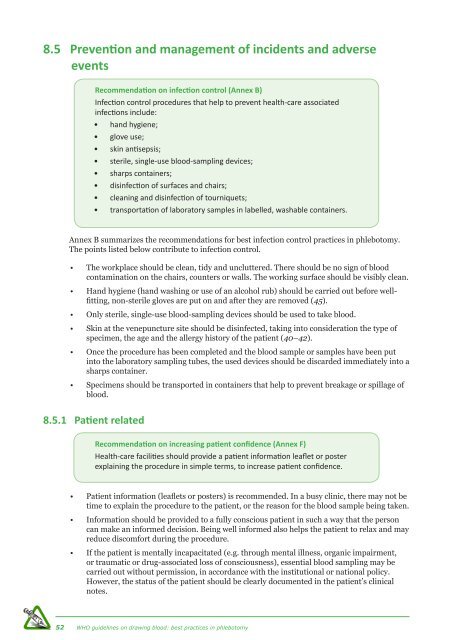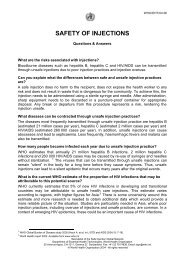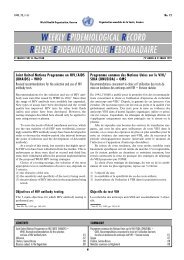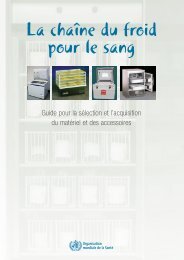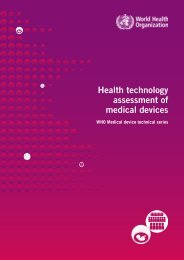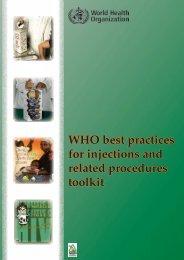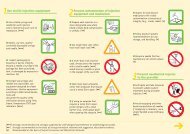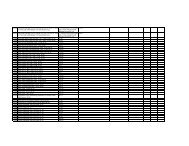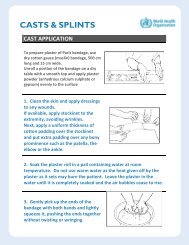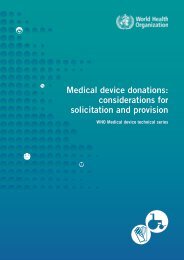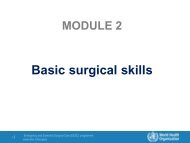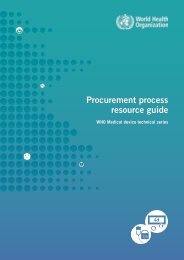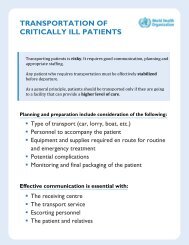WHO Guidelines on Drawing Blood: Best Practices in Phlebotomy
WHO Guidelines on Drawing Blood: Best Practices in Phlebotomy
WHO Guidelines on Drawing Blood: Best Practices in Phlebotomy
- No tags were found...
Create successful ePaper yourself
Turn your PDF publications into a flip-book with our unique Google optimized e-Paper software.
8.5 Preventi<strong>on</strong> and management of <strong>in</strong>cidents and adverse<br />
events<br />
Recommendati<strong>on</strong> <strong>on</strong> <strong>in</strong>fecti<strong>on</strong> c<strong>on</strong>trol (Annex B)<br />
Infecti<strong>on</strong> c<strong>on</strong>trol procedures that help to prevent health-care associated<br />
<strong>in</strong>fecti<strong>on</strong>s <strong>in</strong>clude:<br />
• hand hygiene;<br />
• glove use;<br />
• sk<strong>in</strong> antisepsis;<br />
• sterile, s<strong>in</strong>gle-use blood-sampl<strong>in</strong>g devices;<br />
• sharps c<strong>on</strong>ta<strong>in</strong>ers;<br />
• dis<strong>in</strong>fecti<strong>on</strong> of surfaces and chairs;<br />
• clean<strong>in</strong>g and dis<strong>in</strong>fecti<strong>on</strong> of tourniquets;<br />
• transportati<strong>on</strong> of laboratory samples <strong>in</strong> labelled, washable c<strong>on</strong>ta<strong>in</strong>ers.<br />
Annex B summarizes the recommendati<strong>on</strong>s for best <strong>in</strong>fecti<strong>on</strong> c<strong>on</strong>trol practices <strong>in</strong> phlebotomy.<br />
The po<strong>in</strong>ts listed below c<strong>on</strong>tribute to <strong>in</strong>fecti<strong>on</strong> c<strong>on</strong>trol.<br />
• The workplace should be clean, tidy and uncluttered. There should be no sign of blood<br />
c<strong>on</strong>tam<strong>in</strong>ati<strong>on</strong> <strong>on</strong> the chairs, counters or walls. The work<strong>in</strong>g surface should be visibly clean.<br />
• Hand hygiene (hand wash<strong>in</strong>g or use of an alcohol rub) should be carried out before wellfitt<strong>in</strong>g,<br />
n<strong>on</strong>-sterile gloves are put <strong>on</strong> and after they are removed (45).<br />
• Only sterile, s<strong>in</strong>gle-use blood-sampl<strong>in</strong>g devices should be used to take blood.<br />
• Sk<strong>in</strong> at the venepuncture site should be dis<strong>in</strong>fected, tak<strong>in</strong>g <strong>in</strong>to c<strong>on</strong>siderati<strong>on</strong> the type of<br />
specimen, the age and the allergy history of the patient (40–42).<br />
• Once the procedure has been completed and the blood sample or samples have been put<br />
<strong>in</strong>to the laboratory sampl<strong>in</strong>g tubes, the used devices should be discarded immediately <strong>in</strong>to a<br />
sharps c<strong>on</strong>ta<strong>in</strong>er.<br />
• Specimens should be transported <strong>in</strong> c<strong>on</strong>ta<strong>in</strong>ers that help to prevent breakage or spillage of<br />
blood.<br />
8.5.1 Patient related<br />
Recommendati<strong>on</strong> <strong>on</strong> <strong>in</strong>creas<strong>in</strong>g patient c<strong>on</strong>fidence (Annex F)<br />
Health-care facilities should provide a patient <strong>in</strong>formati<strong>on</strong> leaflet or poster<br />
expla<strong>in</strong><strong>in</strong>g the procedure <strong>in</strong> simple terms, to <strong>in</strong>crease patient c<strong>on</strong>fidence.<br />
• Patient <strong>in</strong>formati<strong>on</strong> (leaflets or posters) is recommended. In a busy cl<strong>in</strong>ic, there may not be<br />
time to expla<strong>in</strong> the procedure to the patient, or the reas<strong>on</strong> for the blood sample be<strong>in</strong>g taken.<br />
• Informati<strong>on</strong> should be provided to a fully c<strong>on</strong>scious patient <strong>in</strong> such a way that the pers<strong>on</strong><br />
can make an <strong>in</strong>formed decisi<strong>on</strong>. Be<strong>in</strong>g well <strong>in</strong>formed also helps the patient to relax and may<br />
reduce discomfort dur<strong>in</strong>g the procedure.<br />
• If the patient is mentally <strong>in</strong>capacitated (e.g. through mental illness, organic impairment,<br />
or traumatic or drug-associated loss of c<strong>on</strong>sciousness), essential blood sampl<strong>in</strong>g may be<br />
carried out without permissi<strong>on</strong>, <strong>in</strong> accordance with the <strong>in</strong>stituti<strong>on</strong>al or nati<strong>on</strong>al policy.<br />
However, the status of the patient should be clearly documented <strong>in</strong> the patient’s cl<strong>in</strong>ical<br />
notes.<br />
52 <str<strong>on</strong>g>WHO</str<strong>on</strong>g> guidel<strong>in</strong>es <strong>on</strong> draw<strong>in</strong>g blood: best practices <strong>in</strong> phlebotomy


